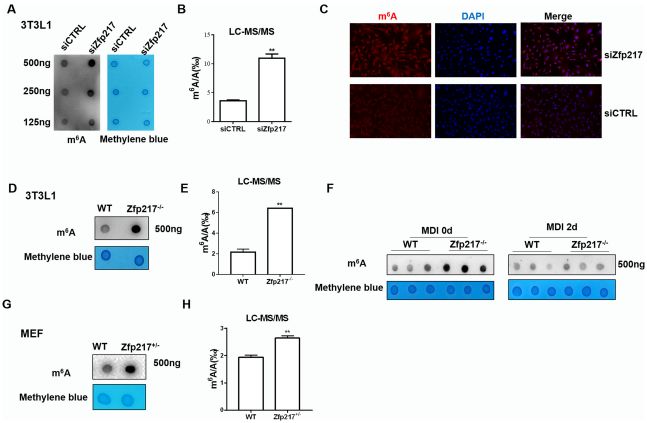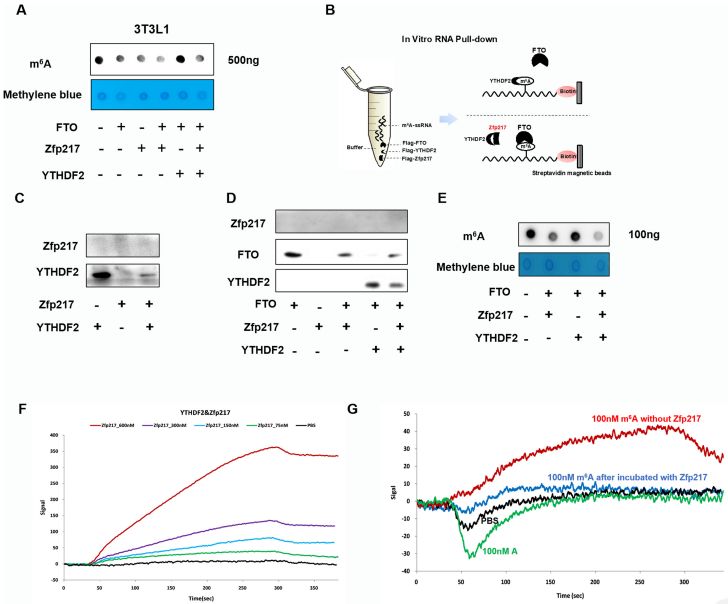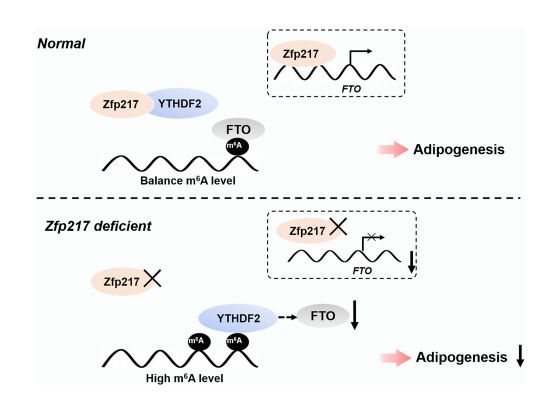The global incidence of obesity and type 2 diabetes has increased significantly over the past 30 years and has seriously jeopardized people's lives. Adipose tissue is thought to be associated with such diseases, so manipulation of differentiation and maturation of adipocytes is expected to be used in clinical treatment. Numerous studies have elucidated the important role of transcription and epigenetics (DNA and histone modifications) in the process of adipogenesis, but it is unclear how post-transcriptional regulation affects lipogenesis.
Recently, researchers at Huazhong Agricultural University have made new progress in this field. Song Yuxing and Yang Yang, Ph.D. students from the College of Animal Science and Technology of Huazhong Agricultural University, are the first authors. Professor Peng Jian and Professor Jiang Siwen are co-authors. They published an article entitled "Zfp217 mediates m6A mRNA methylation to orchestrate transcriptional and posttranscriptional regulation to promote adipogenic differentiation" in Nucleic Acids Research. It was first discovered that ZFP217 directly activates the expression of m6A demethylase FTO and combines it. The m6A reading protein YTHDF2 promotes the binding of FTO to m6A mRNA, thereby promoting the differentiation of adipocytes.
Zinc finger protein 217 (Zfp217) is a well-known oncoprotein that is upregulated in a variety of cancers and is essential for the differentiation of embryonic stem cells. Notably, Zfp217 closely linked gene transcription to m6A modification on nascent RNA, suggesting that Zfp217 plays a key role in coordinating epigenetic and epigenetic transcriptome networks. As a result, the researchers speculated that Zfp217 may accelerate lipogenesis by modulating m6A modification.
Zfp217 inhibition leads to an increase in m6A modification
To explore the role of Zfp217 in adipogenic differentiation, the researchers first used siRNA to perform a function-deficient experiment. Knockdown of Zfp217 significantly blocked lipogenesis, as evidenced by decreased oil red O staining levels and decreased expression levels of key adipogenic genes PPARγ, aP2, LPL, and adiponectin. In addition, after the Zfp217 gene was completely knocked out by the CRISPR-Cas9 system, the lipogenesis in 3T3L1 cells was completely destroyed. In addition, they also commissioned Zfp217 knockout mice from Cyagen and found that Zfp217+/- mouse embryonic fibroblasts had reduced lipogenesis. These results indicate that Zfp217 has an important influence on adipogenic differentiation.
To screen for the function of Zfp217 in 3T3L1 cells, the researchers examined m6A modifications in mRNA by dot blot and liquid chromatography tandem mass spectrometry (LC-MS/MS). The level of m6A in 3T3L1 cells was generally increased after treatment with siRNA and CRISPR-Cas9 system compared to the control group (Fig. 1). The m6A modification of Zfp217+/- mouse embryonic fibroblasts was also significantly increased compared to wild-type cells. These results indicate that Zfp217 is critical for cellular m6A RNA methylation.

Figure 1. Zfp217 inhibition leads to increased m6A modification in 3T3L1 cells
Zfp217 directly activates FTO transcription
Although the inactivation of Zfp217 affects the m6A modification, but Zfp217 itself is not a methyltransferase or a demethylase, how does Zfp217 inhibit m6A mRNA methylation? The researchers then examined the expression of key proteins associated with m6A methylation. Interestingly, after Zfp217 was knocked down, the expression of methyltransferase METTL3 was increased, while the expression of demethylase FTO was decreased. Further studies indicate that FTO mRNA levels are regulated by Zfp217 overexpression or knockdown. Therefore, they wanted to verify whether Zfp217 regulates FTO expression as a transcription factor.
The researchers used a dual luciferase reporter system to verify that Zfp217 enhances FTO promoter activity, whereas deletion of the binding sequence on the FTO promoter inhibits its activity, indicating direct regulation of FTO by Zfp217 (Figure 2). At the same time, FTO rescued the formation of obstruction of lipogenesis due to the lack of Zfp217 and increased the expression of PPARγ, aP2, LPL and adiponectin. These results indicate that Zfp217 acts as a transcription factor in combination with the promoter of the FTO gene to enhance lipogenesis.

Figure 2. Zfp217 activates FTO transcription
Zfp217 interacts with YTHDF2
Previous reports claim that Zfp217 functions by interacting with embryonic development and other proteins in the tumor. To further explore the molecular mechanism by which Zfp217 promotes lipogenesis, the researchers conducted an immunoprecipitation (Co-IP) experiment. They found a specific interaction between Zfp217 and YTHDF2 in both 3T3L1 cells and HEK293T cells.
To confirm subcellular interactions, they isolated the nucleus and cytoplasmic components to determine Zfp217 and YTHDF2 expression. They found that both proteins are distributed throughout the cell, but Zfp217 is expressed more in the cytoplasm than in the nucleus. In addition, confocal microscopy analysis also observed that both proteins were located in both the nucleus and cytoplasm, suggesting that YTHDF2 may play a specific role in Zfp217-dependent lipogenesis.
Previous studies have found that YTHDF2 can maintain m6A levels by inhibiting FTO activity under heat stress. The researchers then further analyzed the interaction between YTHDF2 and Zfp217 and FTO. As expected, overexpression of FTO and Zfp217 showed lower levels of m6A, and YTHDF2 blocked the demethylase activity of FTO, while Zfp217 acted as a regulator, biasing the bias toward demethylation (Figure 3). .

Figure 3. Zfp217 affects the competition between YTHDF2 and FTO
In addition, they confirmed the direct competition between FTO and YTHDF2 in targeting m6A ssRNA by m6A RNA pull-down assay. Clearly, Zfp217, which does not bind to RNA, interferes with the location of YTHDF2, allowing FTO to bind to RNA. Subsequent experiments also demonstrated that Zfp217 interacts with YTHDF2 to maintain the m6A demethylation activity of FTO.
Collectively, this study demonstrates that ZFP217 is involved in the important role of lipogenesis in transcription (activated FTO) and post-transcriptional (affecting mRNA m6A modification) levels, and found that ZFP217 creatively influences m6A reading protein YTHDF2 and eraser FTO competition The role model of sexual binding to target mRNA provides a new idea for understanding the dynamic regulation process of m6A.

Figure 4. Schematic diagram of Zfp217 regulating m6A modification in lipogenesis
This is the first time in the world to report the molecular mechanism of RNA epigenetic regulation of fat cell production, and it is a new understanding of the regulation mechanism of fat cell production, which is of great significance for expanding relevant research fields.
if you are having any inquiry regarding the products, please send us at your earliest.
Should you need further information please write to us, We are at your service.
Diesel Engine Spare Parts,Engine Cylinder Liner,Engine Piston,Marine Engine Spare Parts,Diesel Generator Spare Parts
ZhouShan HeCheng Machinery Co., LTD. , https://www.hcmarineparts.com